Barcelona
November 2005
|
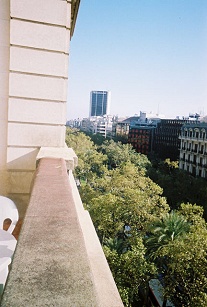
From the terrace off my room, looking down Diagonal;
the trees below are plane trees (sycamores, to us) and date palms, hiding many lanes of
traffic.
|
|
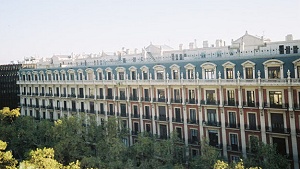
The building across the street was a full block long;
it was painted pale yellow with cream trim on either end, and red with white trim in the middle;
the roof color was actually a deep blue-green.
|
|
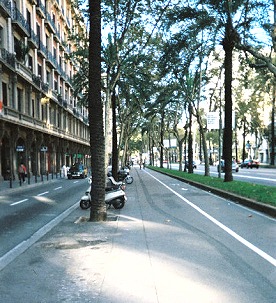
From street level, Diagonal is a very pedestrian friendly main street.
Note the two lanes of one-way traffic on the left, the pedestrian walkway with parking for bikes
and motorbikes, the narrow bicycle lane, the grass...and then six lanes of traffic--three each way,
the curbside one for buses and taxis only. One row of rees is planted in the pavement, and one in
the grass. Across that is another pedestrian/bicycle area, with its own grassy strip and double row
of trees, then two more lanes one-way the other way. The traffic lights are set up so that you can
walk across the entire wide street on one light cycle, or if you prefer to walk along either of the
pedestrian walkways, you can cross the intersecting streets on special pedestrian lights.
|
|
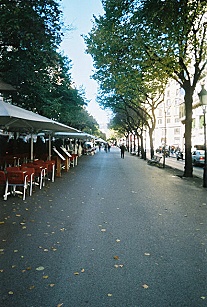
Ramblas de Catalunya is an important street that
intersects Diagonal and goes down to the Placa de Catalunya, where at an angle the very old street
Las Ramblas takes you down into the oldest part of the city. At this level, it has a broad central
median--wide enough for outdoor cafe seating, though in winter it's not used as much. There are two
lanes of one-way traffic on either side, then wide sidewalks and shops and apartments. It's a very
pleasant walking environment, and you can just barely make out a vague lavender smudge between the
last of the trees--in real life, that was clearly visible as a lovely mountain, Tibidabo, with a
church on top, which was golden in the afternoon sunlight. It seemed to float above the trees, its
base cut off by their foliage so that it looked magical.
|
|
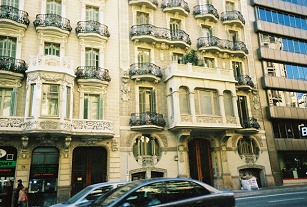 Barcelona architecture combines
intricate, even lavish, detail with a lightness, an airiness, that goes with its climate. These
lacy iron balconies with their complex curves decorate without overwhelming two facades interesting
in themselves. I can't remember if this was on Ramblas de Catalunya or Passaig de Gracia, the next
street beyond Ramblas de Catalunya (from where I was staying, almost at the corner of Carre de
Muntaner). But any street you walk in this area is likely to have something as interesting. I could
have taken hundreds, even thousands, of pictures of equally beautiful buildings. Barcelona architecture combines
intricate, even lavish, detail with a lightness, an airiness, that goes with its climate. These
lacy iron balconies with their complex curves decorate without overwhelming two facades interesting
in themselves. I can't remember if this was on Ramblas de Catalunya or Passaig de Gracia, the next
street beyond Ramblas de Catalunya (from where I was staying, almost at the corner of Carre de
Muntaner). But any street you walk in this area is likely to have something as interesting. I could
have taken hundreds, even thousands, of pictures of equally beautiful buildings.
|
|
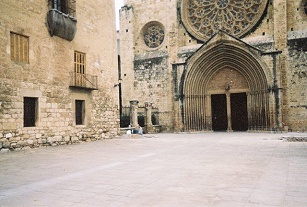 On Friday, my host took me
to lunch at the Autonomous University of Barcelona, which is far from the city (for political
reasons important when it was founded)--actually on the far side of a mountain from Barcelona.
Nearby is St. Cugat, an old town now in the process of rapid development. This is the courtyard and
facade of the monastery church of St. Cugat. Picture taking here was limited because something was
being filmed just outside this courtyard and I couldn't get back further without interfering. Dr.
Barcelo wasn't sure if it was a movie, a TV show episode, or a commercial. (It involved a stretch
limo with some kind of giant sausage on top, actors in costume, and a crowd of extras--actors or
not I don't know--in ordinary clothes, plus trucks with generators, huge light arrays, and people
with bullhorns.) For scale, look at the two truncated columns just to the left of center: the
little blips at the base of the near one are men working in an excavation. You can see that those
columns once supported a round arch, an entrance of some sort. The building on the left is a clergy
residence and the funny-looking something hanging from the balcony is palm fronds. On Friday, my host took me
to lunch at the Autonomous University of Barcelona, which is far from the city (for political
reasons important when it was founded)--actually on the far side of a mountain from Barcelona.
Nearby is St. Cugat, an old town now in the process of rapid development. This is the courtyard and
facade of the monastery church of St. Cugat. Picture taking here was limited because something was
being filmed just outside this courtyard and I couldn't get back further without interfering. Dr.
Barcelo wasn't sure if it was a movie, a TV show episode, or a commercial. (It involved a stretch
limo with some kind of giant sausage on top, actors in costume, and a crowd of extras--actors or
not I don't know--in ordinary clothes, plus trucks with generators, huge light arrays, and people
with bullhorns.) For scale, look at the two truncated columns just to the left of center: the
little blips at the base of the near one are men working in an excavation. You can see that those
columns once supported a round arch, an entrance of some sort. The building on the left is a clergy
residence and the funny-looking something hanging from the balcony is palm fronds.
|
|
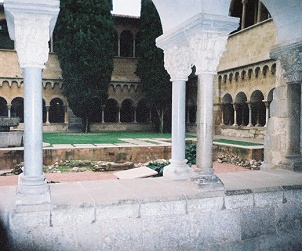
Unfortunately, my throwaway camera
insisted on flashing, and thus bleached out the near columns and the details of their carving
(fantastic faces and beasts)...but the cloister is a wonderfully peaceful place even now. It dates
from the 11th century, and recent excavations suggest that it may be on the site of a Roman army
camp. The museum here is beautifully designed and very informative, with models of the monastery at
different stages of its history. The models have roofs, but sit on glass...with a mirror
underneath, angled so you can see how the rooms were laid out.
|
|
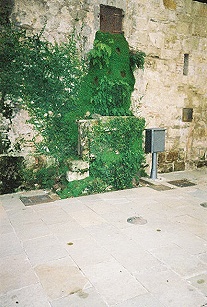
On the other side of the
clergy-housing building is this curious affair...there's a stone basin with steps up to it, but the
basin (and the wall above it) are covered with ferns. When I went closer, I found that the
fine-textured fern 'flowing" down the wall is maidenhair fern, just like ours in Texas. I don't
know the source of the water--it could be a gray-water outlet, or overflow from a rainwater cistern
or...perhaps it's best not to know. Anyway, it's very beautiful.
|
|
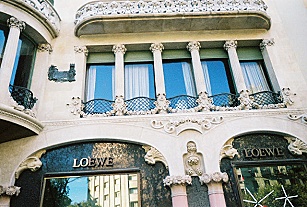
One of the most beautiful store buildings I saw was
this one, Loewe. I rested on a bench in front of it, munching a pastry from a nearby shop, and
enjoyed staring at one detail after another. The main entrance is on the corner, under that round
"thing."
|
|
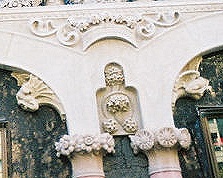
For instance: these fantastic heads above the flower
capitals of the columns--no two alike and all delightful.
|
|
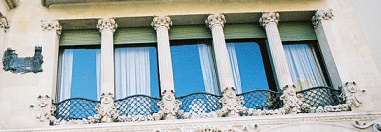
And above, this window ornamented with twisted columns
linked by a floral garland, and then the lacy little iron "balconies".
|
|
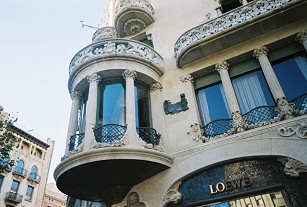
Above the entrance was this sort of hanging turret,
crowned by a bit of iron lacework, and with smaller half-rounds above it. I could have spent hours
photographing just this one building...and there are so many!
|
|
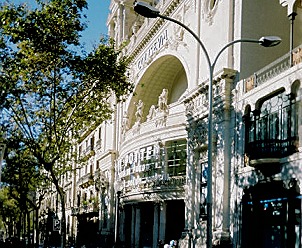
For instance, this movie theater (showing the new Harry
Potter movie) has a splendid St. George and dragon beneath that noble arch...and a nice frieze in
relief above it.
|
|
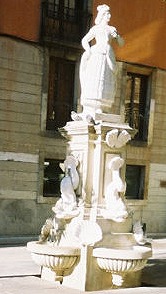
In a courtyard between buildings, just
off La Ramblas, I found this charming little fountain with four dolphins and a lady on top. I was
just too slow to capture the pigeon perched on the fan in her left hand. Surprising delights like
this show up almost everywhere you look. The center of this courtyard had a little grass and some
benches.
|
|
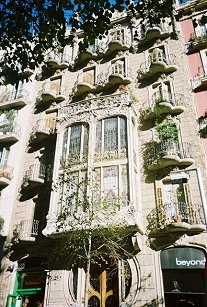
On Rambla de Catalunya, I had stopped for another
pastry...and across from me was this gorgeous building. The entrance doors are set behind a
circular opening; above, the projecting section has huge stained glass windows. On either side and
above the balconies have trefoil bases, and the grills have three-fold bulgy curves, rather like a
garlic bulb. This was the last shot in the camera, on the last day of my trip...and it makes a fine
farewell to Barcelona. I had taken some scenic views from an overlook west of the city (on the way
back from St. Cugat) but between the weather (hazy and windy) and the camera's limitations, I
didn't think any of those would work well in this setting. As for pictures of the Gaudi buildings I
saw--you really need a professional setup to capture the charm and the detail.
|

Back to Archive
 
|

![]()
